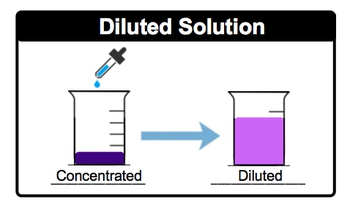In this example question, it says what volume and milliliters, a 5.2 molar hydrobromic acid must be used to prepare 3.5 liters of 2.7 molar hydrobromic acid. Now how do we know this is a dilution question? Well, typically in a dilution question we're only talking about one compound. And with that one compound to be talking about dilution, we tend to deal with two molarities. So the fact that we're dealing with just hydrobromic acid and we have two molarities associated with it is a strong indication that we're dealing with a dilution.
So that means we're going to use M1V1=M2V2. Now remember, M1 is larger than M2 because M1 represents your concentrated solution before you've begun dilution. Because of this, 5.2 molar has to be our M1. It's the larger molarity associated with M1 is V1. We don't see any number around it, so V1 is what we're looking for. Now remember also that the word of when it's in between 2 numbers, that means multiply. We're going to say here that this is the smaller molarity, so this has to be M2. So that's our diluted molarity.
We're multiplying it with 3.5 liters. So based on the dilution equation, 3.5 liters has to be V2. We're going to isolate V1, so divide both sides by 5.2 molar. The molarities cancel out and look, we'll have V1, but here it'll be in liters so that comes out to be 1.8173 liters. We want the answer milliliters, so just do a quick metric prefix conversion. Leaders on the bottom, milliliters on top. One milli is 10 to the -3, so leaders cancel out and that comes out to be 1817.3 milliliters.
Here 5235 and 27 all have two sig figs. So if we wanted two significant figures here, we just write this as 1800 milliliters. Oops, 1800 milliliters as our final answer. So just remember when we're dealing with one compound and we have different molarities, that's a strong indication that we're dealing with dilution equation. So use the dilution formula and solve for the missing variable.



